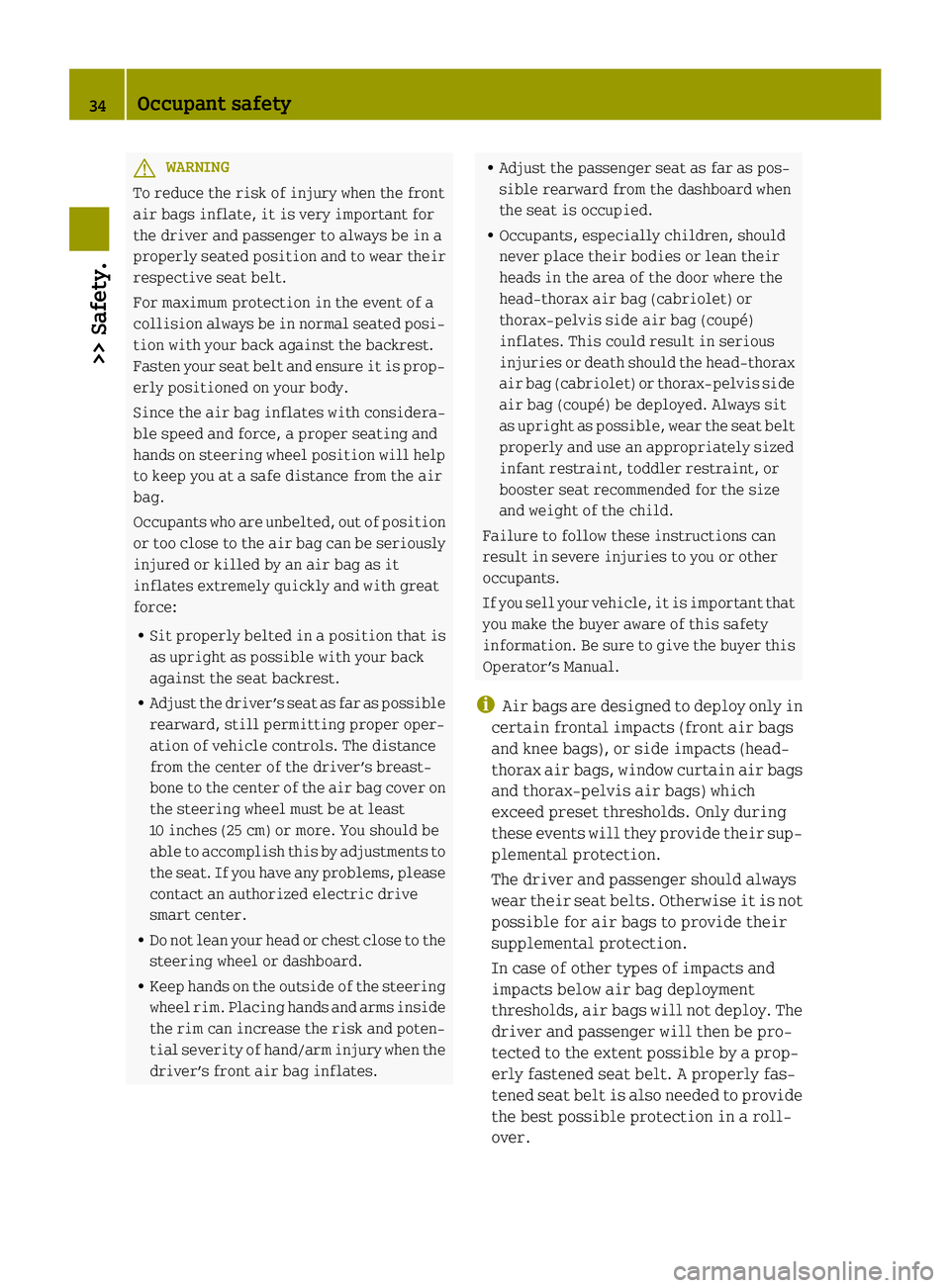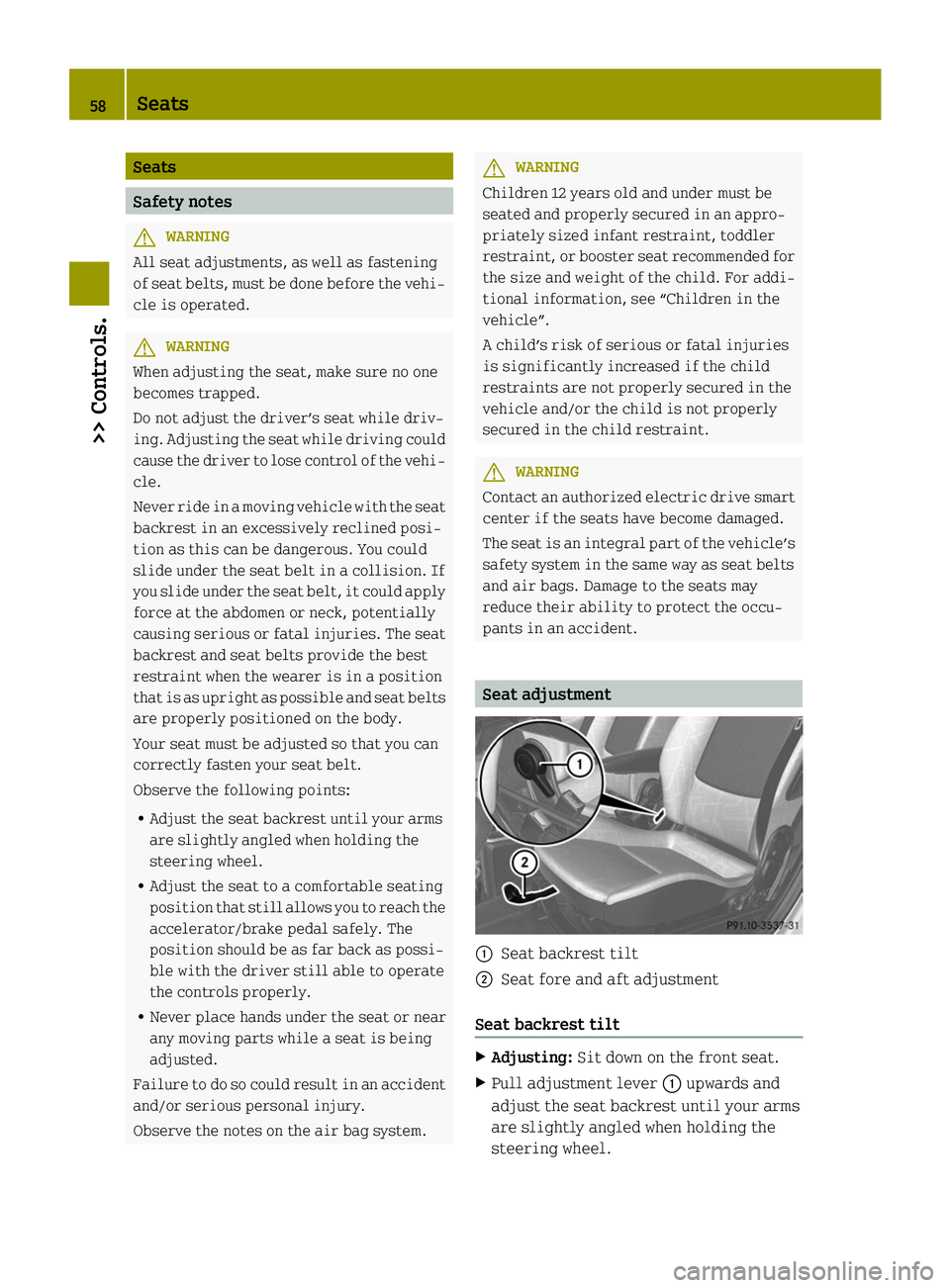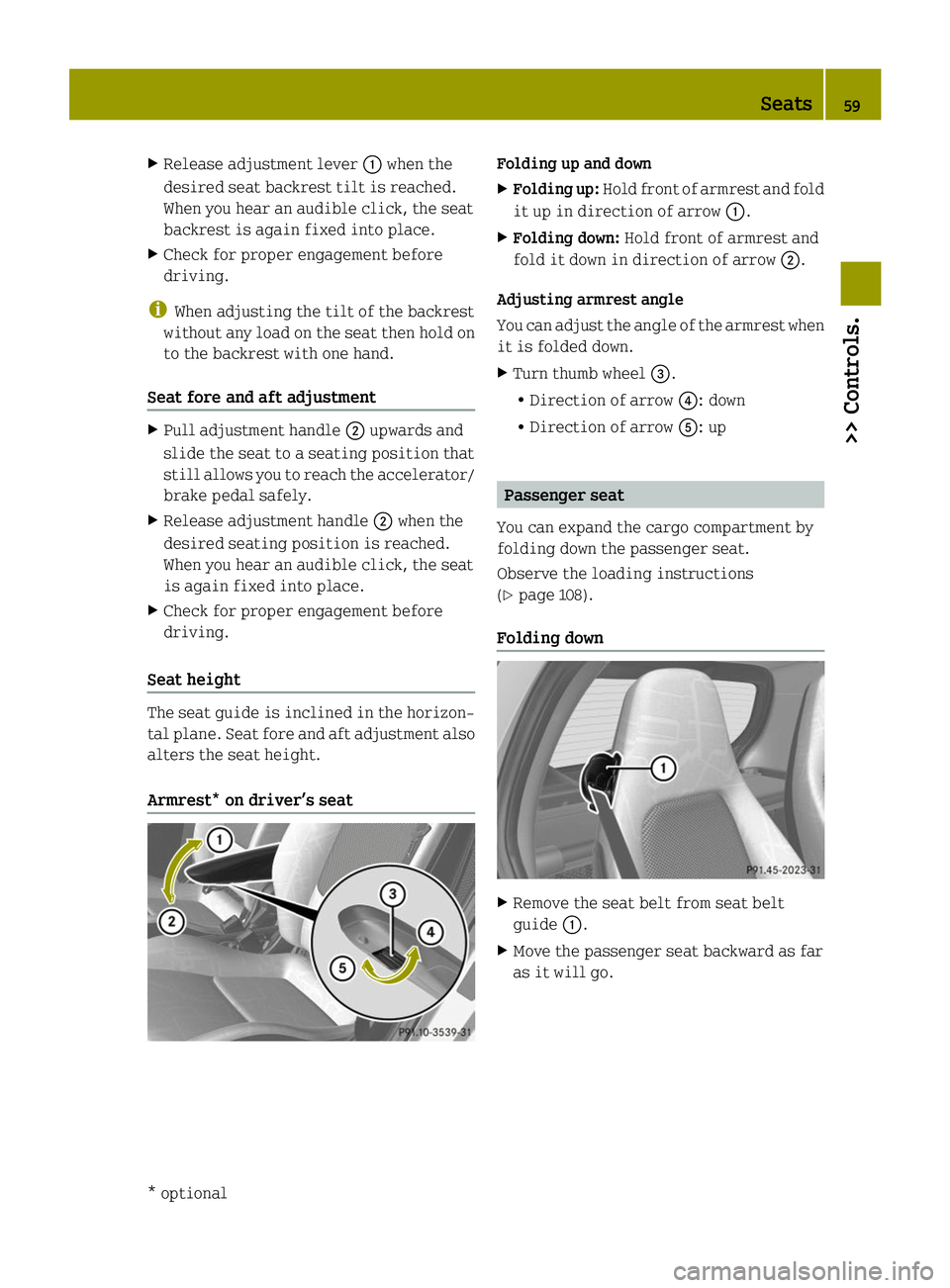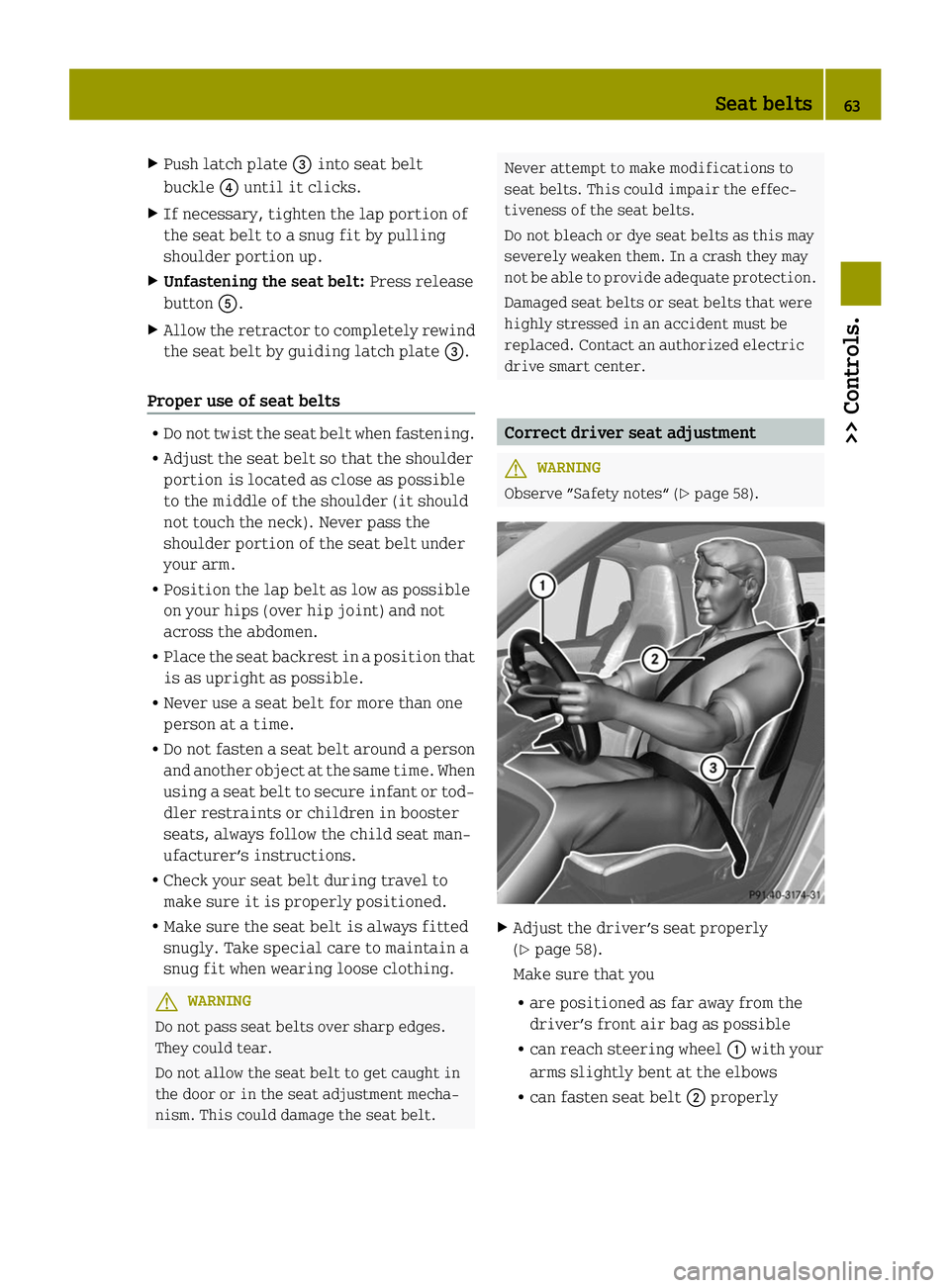driver seat adjustment SMART FORTWO COUPE ELECTRIC DRIVE 2014 Owners Manual
[x] Cancel search | Manufacturer: SMART, Model Year: 2014, Model line: FORTWO COUPE ELECTRIC DRIVE, Model: SMART FORTWO COUPE ELECTRIC DRIVE 2014Pages: 222, PDF Size: 16.17 MB
Page 36 of 222

G
WARNING
To reduce the risk of injury when the front
air bags inflate, it is very important for
the driver and passenger to always be in a
properly seated position and to wear their
respective seat belt.
For maximum protection in the event of a
collision always be in normal seated posi-
tion with your back against the backrest.
Fasten your seat belt and ensure it is prop-
erly positioned on your body.
Since the air bag inflates with considera-
ble speed and force, a proper seating and
hands on steering wheel position will help
to keep you at a safe distance from the air
bag.
Occupants who are unbelted, out of position
or too close to the air bag can be seriously
injured or killed by an air bag as it
inflates extremely quickly and with great
force:
R Sit properly belted in a position that is
as upright as possible with your back
against the seat backrest.
R Adjust the driver’s seat as far as possible
rearward, still permitting proper oper-
ation of vehicle controls. The distance
from the center of the driver’s breast-
bone to the center of the air bag cover on
the steering wheel must be at least
10 inches (25 cm) or more. You should be
able to accomplish this by adjustments to
the seat. If you have any problems, please
contact an authorized electric drive
smart center.
R Do not lean your head or chest close to the
steering wheel or dashboard.
R Keep hands on the outside of the steering
wheel rim. Placing hands and arms inside
the rim can increase the risk and poten-
tial severity of hand/arm injury when the
driver’s front air bag inflates. R
Adjust the passenger seat as far as pos-
sible rearward from the dashboard when
the seat is occupied.
R Occupants, especially children, should
never place their bodies or lean their
heads in the area of the door where the
head-thorax air bag (cabriolet) or
thorax-pelvis side air bag (coupé)
inflates. This could result in serious
injuries or death should the head-thorax
air bag (cabriolet) or thorax-pelvis side
air bag (coupé) be deployed. Always sit
as upright as possible, wear the seat belt
properly and use an appropriately sized
infant restraint, toddler restraint, or
booster seat recommended for the size
and weight of the child.
Failure to follow these instructions can
result in severe injuries to you or other
occupants.
If you sell your vehicle, it is important that
you make the buyer aware of this safety
information. Be sure to give the buyer this
Operator’s Manual.
i Air bags are designed to deploy only in
certain frontal impacts (front air bags
and knee bags), or side impacts (head-
thorax air bags, window curtain air bags
and thorax-pelvis air bags) which
exceed preset thresholds. Only during
these events will they provide their sup-
plemental protection.
The driver and passenger should always
wear their seat belts. Otherwise it is not
possible for air bags to provide their
supplemental protection.
In case of other types of impacts and
impacts below air bag deployment
thresholds, air bags will not deploy. The
driver and passenger will then be pro-
tected to the extent possible by a prop-
erly fastened seat belt. A properly fas-
tened seat belt is also needed to provide
the best possible protection in a roll-
over. 34
Occupant safety>> Safety.
Page 60 of 222

Seats
Safety notes
G
WARNING
All seat adjustments, as well as fastening
of seat belts, must be done before the vehi-
cle is operated. G
WARNING
When adjusting the seat, make sure no one
becomes trapped.
Do not adjust the driver’s seat while driv-
ing. Adjusting the seat while driving could
cause the driver to lose control of the vehi-
cle.
Never ride in a moving vehicle with the seat
backrest in an excessively reclined posi-
tion as this can be dangerous. You could
slide under the seat belt in a collision. If
you slide under the seat belt, it could apply
force at the abdomen or neck, potentially
causing serious or fatal injuries. The seat
backrest and seat belts provide the best
restraint when the wearer is in a position
that is as upright as possible and seat belts
are properly positioned on the body.
Your seat must be adjusted so that you can
correctly fasten your seat belt.
Observe the following points:
R Adjust the seat backrest until your arms
are slightly angled when holding the
steering wheel.
R Adjust the seat to a comfortable seating
position that still allows you to reach the
accelerator/brake pedal safely. The
position should be as far back as possi-
ble with the driver still able to operate
the controls properly.
R Never place hands under the seat or near
any moving parts while a seat is being
adjusted.
Failure to do so could result in an accident
and/or serious personal injury.
Observe the notes on the air bag system. G
WARNING
Children 12 years old and under must be
seated and properly secured in an appro-
priately sized infant restraint, toddler
restraint, or booster seat recommended for
the size and weight of the child. For addi-
tional information, see “Children in the
vehicle”.
A child’s risk of serious or fatal injuries
is significantly increased if the child
restraints are not properly secured in the
vehicle and/or the child is not properly
secured in the child restraint. G
WARNING
Contact an authorized electric drive smart
center if the seats have become damaged.
The seat is an integral part of the vehicle’s
safety system in the same way as seat belts
and air bags. Damage to the seats may
reduce their ability to protect the occu-
pants in an accident. Seat adjustment
0043
Seat backrest tilt
0044 Seat fore and aft adjustment
Seat backrest tilt X
Adjusting: Sit down on the front seat.
X Pull adjustment lever 0043upwards and
adjust the seat backrest until your arms
are slightly angled when holding the
steering wheel. 58
Seats>> Controls.
Page 61 of 222

X
Release adjustment lever 0043when the
desired seat backrest tilt is reached.
When you hear an audible click, the seat
backrest is again fixed into place.
X Check for proper engagement before
driving.
i When adjusting the tilt of the backrest
without any load on the seat then hold on
to the backrest with one hand.
Seat fore and aft adjustment X
Pull adjustment handle 0044upwards and
slide the seat to a seating position that
still allows you to reach the accelerator/
brake pedal safely.
X Release adjustment handle 0044when the
desired seating position is reached.
When you hear an audible click, the seat
is again fixed into place.
X Check for proper engagement before
driving.
Seat height The seat guide is inclined in the horizon-
tal plane. Seat fore and aft adjustment also
alters the seat height.
Armrest* on driver’s seat Folding up and down
X
Folding up: Hold front of armrest and fold
it up in direction of arrow 0043.
X Folding down: Hold front of armrest and
fold it down in direction of arrow 0044.
Adjusting armrest angle
You can adjust the angle of the armrest when
it is folded down.
X Turn thumb wheel 0087.
R Direction of arrow 0085: down
R Direction of arrow 0083: up Passenger seat
You can expand the cargo compartment by
folding down the passenger seat.
Observe the loading instructions
(Y page 108).
Folding down X
Remove the seat belt from seat belt
guide 0043.
X Move the passenger seat backward as far
as it will go. Seats
59>> Controls.
* optional Z
Page 62 of 222

X
Hold the backrest with one hand back.
X Pull adjustment lever 0044upwards and
unlock the seat backrest.
X Fold the seat backrest forward.
Folding back X
Pull adjustment lever 0044upwards and
unlock the seat backrest.
X Fold the seat backrest backward.
When you hear an audible click, the seat
backrest is again fixed into place.
X Check for proper engagement before
driving.
X Place the seat belt back in seat belt
guide 0043. G
WARNING
When folding the passenger seat backrest
back to its upright position, please make
sure
R nobody becomes trapped
R no obstacles are jammed in the lock
R the adjustment lever has audibly locked
into position
A properly engaged passenger seat back-
rest will help to prevent stored objects in
the cargo compartment from being thrown
about and injuring vehicle occupants dur-
ing
R braking
R vehicle maneuvers
R an accident Seat heating*
The seat heating allows you to heat the
driver’s and passenger seat electrically. The seat heating has two levels.
The indicator lamps on seat heating
switch
0043come on to show which heating
level you have selected. Level Indicator lamps on the switch
off
No indicator lamp on
1
One indicator lamp on
2
Two indicator lamps on
X
Make sure the key is in starter switch
position 1.
X Switching on: Press seat heating
switch 0043repeatedly until the desired
seat heating level is reached.
X Switching off: Press seat heating
switch 0043repeatedly until all indicator
lamps go out.
i Switch on the seat heating and, at the
same time, reduce the temperature in the
vehicle interior. The high‑voltage bat-
tery then consumes less energy.
! If the seat heating is malfunctioning,
the indicator lamp(s) on the switch
come(s) on briefly when you press the
switch and then go(es) out again. Contact
an authorized smart center. 60
Seats>> Controls.
* optional
Page 65 of 222

X
Push latch plate 0087into seat belt
buckle 0085until it clicks.
X If necessary, tighten the lap portion of
the seat belt to a snug fit by pulling
shoulder portion up.
X Unfastening the seat belt: Press release
button 0083.
X Allow the retractor to completely rewind
the seat belt by guiding latch plate 0087.
Proper use of seat belts R
Do not twist the seat belt when fastening.
R Adjust the seat belt so that the shoulder
portion is located as close as possible
to the middle of the shoulder (it should
not touch the neck). Never pass the
shoulder portion of the seat belt under
your arm.
R Position the lap belt as low as possible
on your hips (over hip joint) and not
across the abdomen.
R Place the seat backrest in a position that
is as upright as possible.
R Never use a seat belt for more than one
person at a time.
R Do not fasten a seat belt around a person
and another object at the same time. When
using a seat belt to secure infant or tod-
dler restraints or children in booster
seats, always follow the child seat man-
ufacturer’s instructions.
R Check your seat belt during travel to
make sure it is properly positioned.
R Make sure the seat belt is always fitted
snugly. Take special care to maintain a
snug fit when wearing loose clothing. G
WARNING
Do not pass seat belts over sharp edges.
They could tear.
Do not allow the seat belt to get caught in
the door or in the seat adjustment mecha-
nism. This could damage the seat belt. Never attempt to make modifications to
seat belts. This could impair the effec-
tiveness of the seat belts.
Do not bleach or dye seat belts as this may
severely weaken them. In a crash they may
not be able to provide adequate protection.
Damaged seat belts or seat belts that were
highly stressed in an accident must be
replaced. Contact an authorized electric
drive smart center. Correct driver seat adjustment
G
WARNING
Observe ”Safety notes“ (Y page 58). X
Adjust the driver’s seat properly
(Y page 58).
Make sure that you
R are positioned as far away from the
driver’s front air bag as possible
R can reach steering wheel 0043with your
arms slightly bent at the elbows
R can fasten seat belt 0044properly Seat belts
63>> Controls. Z